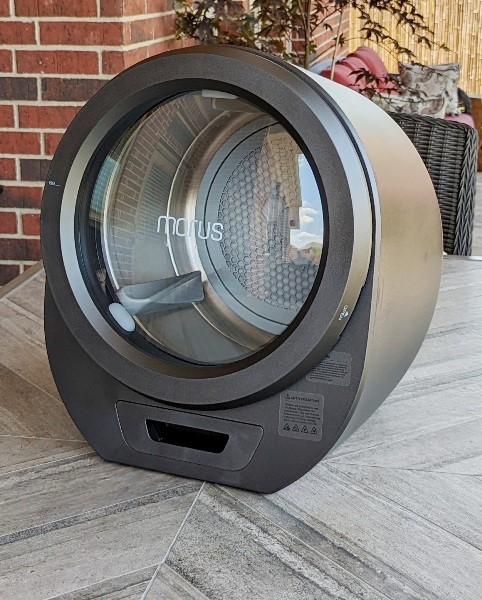
REVIEW – I recently wrote a news post about the Morus Zero portable clothes dryer which according to the Morus website, uses Vacuum+ technology to dry clothes quickly. The website also states that it uses ultraviolet (UV) light to sterilize clothes. Gadgeteer readers responded to my news post saying that the Morus Zero is a scam and that it is essentially an oversized hair dryer. At the time, I didn’t have the Morus Zero to make any conclusions of my own.
I now have the Morus Zero portable clothes dryer in my possession. It successfully dries my clothes, but does it use vacuum technology and UV like the Morus website states it does? My short answer is yes but with a caveat. It does drop the pressure in the dryer slightly below atmospheric pressure which is the engineering definition of “vacuum” and it also has a UVC LED. Still, neither the vacuum nor the UVC LED is strong enough to accomplish what the Morus website claims (60% faster drying with Vacuum+ tech and sterilizing clothes with UVC).
What is it?
The Morus Zero is an electric portable tumble clothes dryer.
What’s in the box?
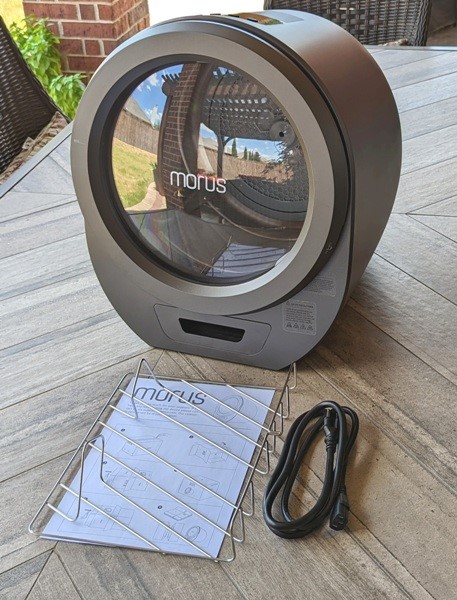
- Morus Zero portable clothes dryer
- Shoe rack
- Power cable
- Unpacking instructions
- I was missing the User Manual (and the Quick Guide) and had to contact Morus for it
Hardware specs
- Capacity: 3.3 lbs.
- Motor type: Brushless DC motor
- Weight: 28.7 lbs.
- Size: 16.3″ W x 19.3″ H x 20.8″ D
- Loading type: Front-load tumble, left-hand swing
- Power: 1000 W – 1300W
- Voltage: 100V – 120V
- Frequency: 50/60 Hz
- Warranty: 12 months
Design and features
Before getting into a discussion of the Morus Zero portable clothes dryer, here’s a description of the two main types of dryers and how clothes dryers work.
Convection dryers and vacuum dryers: The two most common types of dryers are convection dryers and vacuum dryers. Convection dryers are those that involve the movement of hot air to remove moisture.
Vacuum dryers on the other hand rely on reducing the pressure to a very low value and then using a small amount of heat to drive off the moisture. Vacuum dryers are very useful in the pharmaceutical and food processing industries where it is often necessary to dry a product that cannot tolerate high temperatures. A significant reduction in pressure will reduce the boiling point of water significantly enough that it will evaporate at lower temperatures, which allows drying with very little heat.
The type of clothes dryer that we have in our homes is a convection dryer. Vacuum dryers are too large and expensive and not practical for drying clothes. The Morus is a convection dryer.
How convection clothes dryers work: Clothes dryers use circulating air and heat to dry clothes. They draw in air through vents and heat the air using heating elements powered by electricity, gas, or propane. They then use a blower to move the heated air to the clothes. The dryer’s drum rotates to tumble the clothes thus allowing air to circulate around the clothes.
In general, there are two types of convection clothes dryers:
- Vented dryer: These types of dryers vent the hot humid air first through a lint trap and then through a hose that vectors it outside your home so that you don’t have moisture problems in the room where the dryer is placed.
- Condenser dryer: Instead of using a hose to vent the hot humid air outside, these types of dryers direct the hot humid air around condenser coils to cool the air and condense the water out of the air. It then vectors that water to a collection area or to a drainpipe. Heat pump dryers are a type of condenser dryer “that recycle heat in the process of extracting moisture” (Canstar Blue website) and are more energy efficient than other types of dryers.

I received the “Lava Gray” Morus Zero portable clothes dryer to review. It is encased in matte gray plastic and the entire door is made of plastic. As a portable dryer, it has an attractive design.
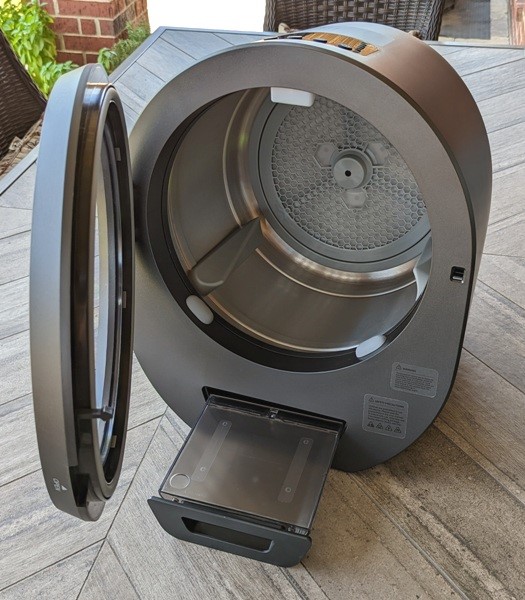
The Morus Zero has a stainless steel drum.
It looks like this dryer was meant to be a condenser type of dryer because it has a plastic tray that is supposed to collect the condensed water.
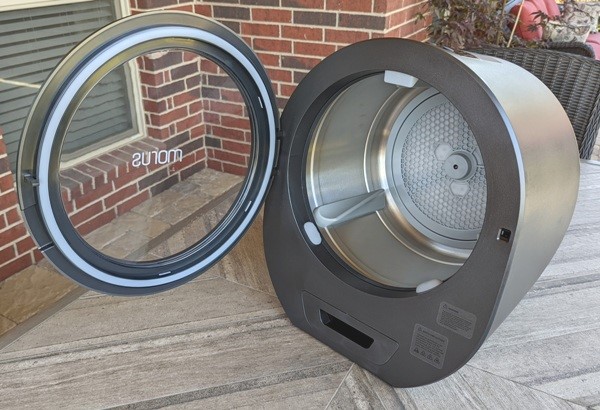
The door of the dryer has a gray silicone seal.
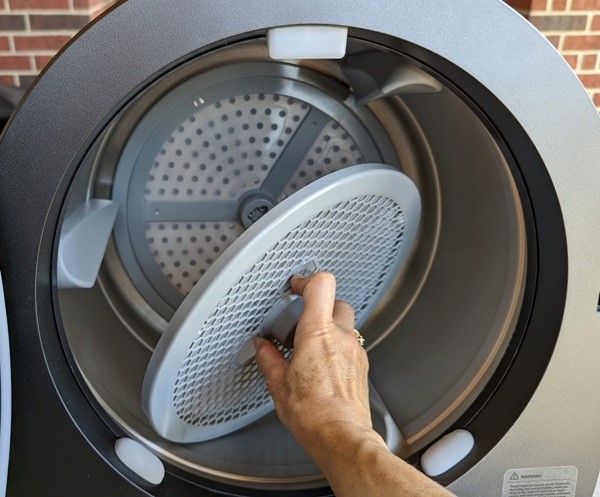
The lint trap, which is made of plastic and mesh material, is located at the back of the inside of the dryer. It is held in place by magnets and is thus easily removed.
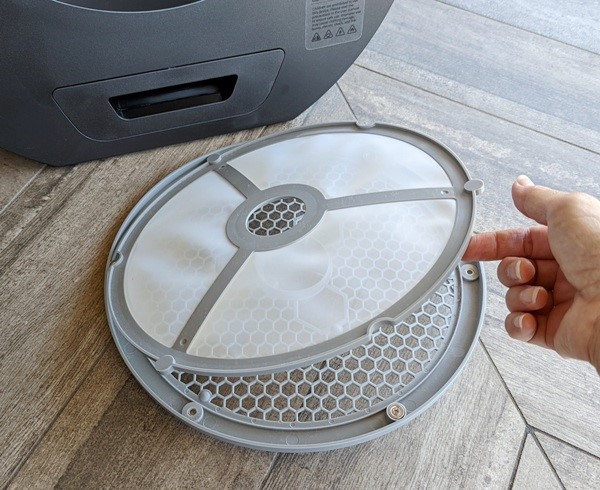
To remove the lint you need to separate the plastic honeycomb-grid cover from the mesh lint trap. They are held together magnetically as well.
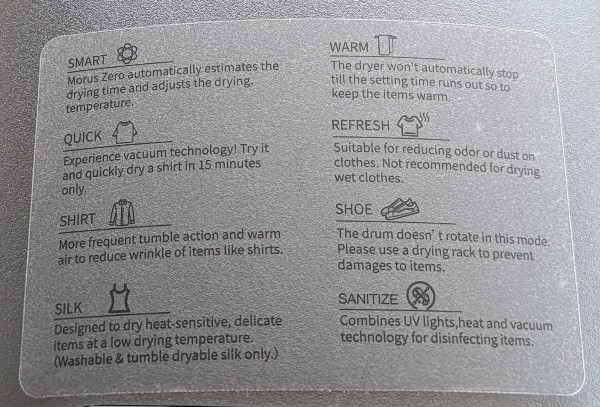
The top of the Morus Zero portable clothes dryer has a sticker for quick reference describing the eight modes available to dry your clothes.
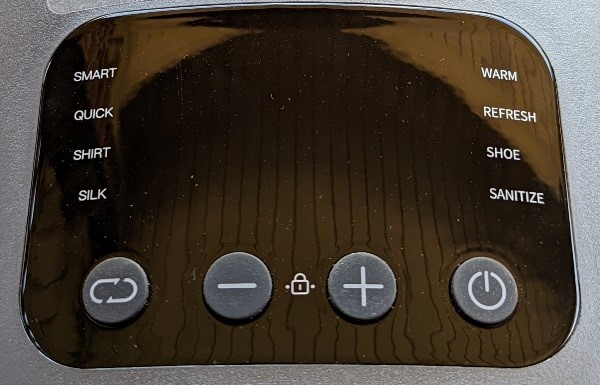
Also located on the top of the dryer is the control panel.
- The circulating-arrows button allows you to select the mode you want.
- The “+” and “-” buttons allow you to change the drying times by 5 degrees at a time. Pressing both the “+” and “-” simultaneously turns the child-safety lock on or off.
- The power button: long pressing it turns the dryer on or off. Short pressing the button starts or pauses the dryer.
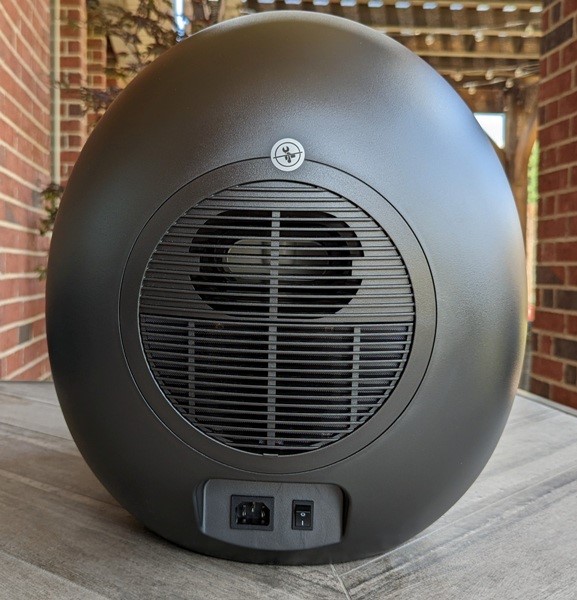
The back of the dryer shows the vents that draw in fresh air and expel hot air. Also located here are the power port and the power on/off switch.
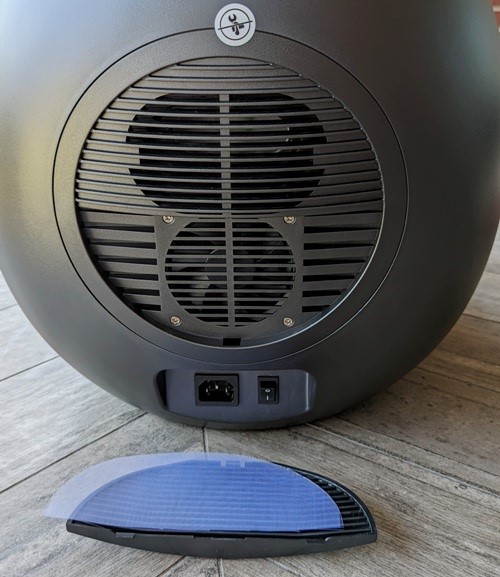
The lower portion of the rear vent has a cover that can be removed revealing a mesh filter to help filter out dust.
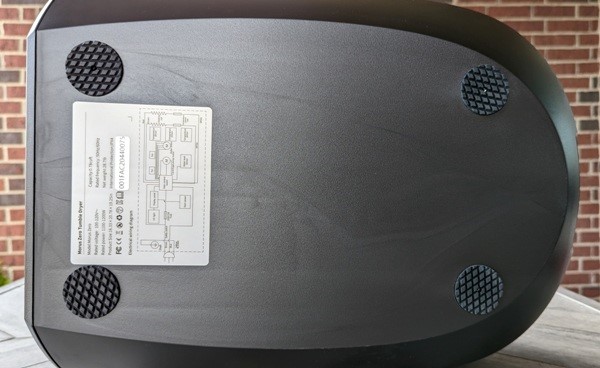
The bottom of the dryer has silicone pads to protect the surface that you place the dryer on. The bottom also contains a wiring diagram for the dryer.
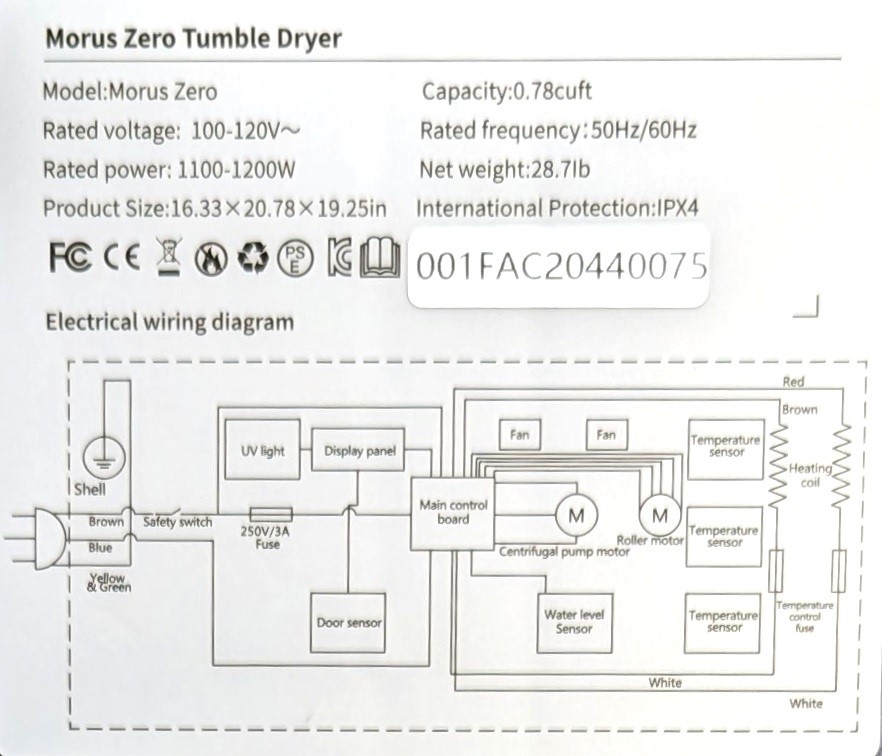
The above is a close-up view of the wiring diagram.
Performance
Drying ability
I placed the Morus Zero portable clothes dryer in my walk-in closet. I then connected the power cord to the dryer and plugged it in. I had to remember to flip the switch on the back of the dryer to the “on” position before I could use it. There are no hoses to hook up.
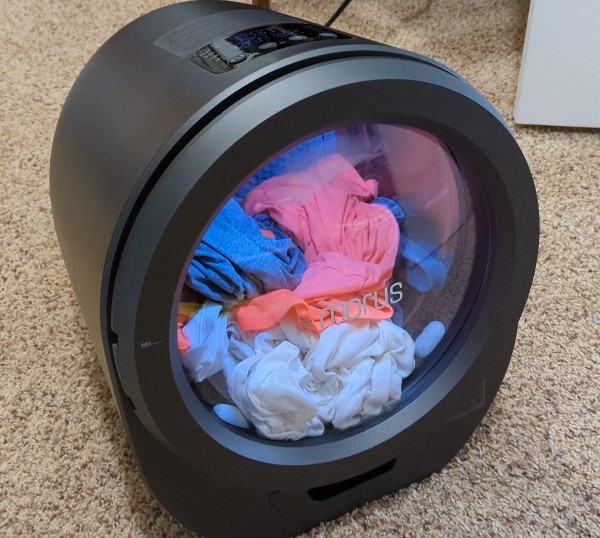
Smart Dry mode: The default settings for the Smart Dry mode:
- Temperature: the dryer automatically adjusts the temperature
- Time: the dryer automatically adjusts the drying time
- The temperature isn’t displayed while using this mode
After washing seven of my size small t-shirts in my full-sized front-loading washing machine, I weighed them (1 lb. 14 oz. when wet), then placed them in the Morus Zero dryer.
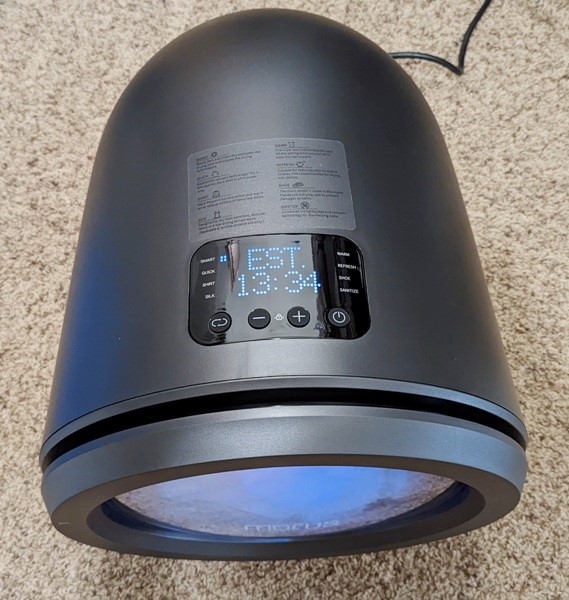
I used the Smart Dry mode to dry them which is supposed to detect the moisture content in the clothes to determine when the clothes are dry and automatically stop at that point. When I started the dryer, it ran for a few seconds, during which the only thing displayed on the control panel was “EST”. Then a 15-minute timer appeared on the control panel and started counting down the time to the end of the cycle.
I noticed after the 15 minutes were up, the dryer kept running. I wasn’t sure what was going on so, in this test, I decided to interrupt the cycle after 18 minutes to see if the shirts were dry. I found that six of the shirts were dry but one was still damp. I removed the six shirts that were dry and finished drying the last shirt. I again interrupted the dryer’s cycle after 5 more minutes to see if the shirt was dry and it was.
When dried, the shirts weighed 1 lb. 7 oz. The above video shows how the drum alternates rotation directions after 30-second time intervals. Additionally, you can hear how loud it is (it’s relatively quiet in my opinion).
In another test, I dried a large bath towel (bath sheet) using the Smart Dry setting. When wet, the towel weighed 2 lb. 13 oz. and after 58 minutes, the towel was dry and weighed 1 lb. 14 oz.
Quick Dry mode: The default settings for the Quick Dry mode:
- Temperature: Auto
- Time: 15 minutes
The Morus Zero portable clothes dryer’s user manual states that you would use this mode to dry a light load. So, in this test, I dried one of my size small t-shirts on the Quick Dry mode. It weighed 8 oz. when wet and after 15 minutes of dry time (this time I did not interrupt the Quick Dry cycle), the dryer stopped automatically. The shirt was dry and weighed 5.5 oz.
Shirt mode: The default settings for the Shirt mode:
- Temperature: 140 degrees F
- Time: 60 minutes
I washed a cotton button-up short-sleeve shirt and dried it using the Shirt mode. It weighed 11 oz. when wet and weighed 8 oz. when dry. I left the dryer on the default time setting of 60 minutes, but I’m fairly sure it dried in less time than that.
The Shirt mode is supposed to use “more frequent tumble action to reduce wrinkles”. I didn’t notice any difference in the frequency or speed of the tumbling and the shirt didn’t come out better using this mode than using my full-size dryer.
Silk mode: The default settings for Silk mode:
- Temperature: 104 degrees F
- Time: 60 minutes
I washed a couple of my scarves (one was silk, the other was unknown material) and used the Silk mode to dry them. They were 1 lb. 12 oz. when wet. After 15 minutes had passed, the dryer stopped. The silk scarf was dry but the other was still wet and needed more drying time. I used the Smart Dry mode to finish drying it. After 15 minutes, it was dry. Both scarves weighed 13 oz. when dry.
Warm mode: The default settings for the Warm mode:
- Temperature: 140 degrees F
- Time: 30 minutes
I used the Warm mode to warm up one of our towels. After about 10 minutes or so, it was nice and warm. I can see the benefit of using this in the winter months. Mmm, warm towels…
Refresh mode: The default settings for the Refresh mode:
- Temperature: No heat is used on this setting
- Time: 60 minutes
I used the Refresh mode to “refresh” a shirt I had worn earlier in the week. This mode doesn’t use heat but relies on air circulation and the UVC LED to do the work. This mode is supposed to “freshen up” your clothes and get rid of odors. My shirt didn’t have any odors before using the dryer so I didn’t notice any difference after using it.
Shoe mode: The default settings for the Shoe mode:
- Temperature: 140 degrees F
- Time: 60 minutes
I washed a pair of my canvas shoes and selected the Shoe mode to dry them so that the dryer’s drum wouldn’t rotate while the shoes were inside. When wet, the shoes weighed 1 lb. 9 oz.
I can’t tell how much time it took to dry my shoes because the cycle kept stopping even when the shoes were still damp inside. I had to run the cycle a few times (each time the dryer ran for about 5-10 minutes) to completely dry my shoes. I estimate it took about 1.5 to 2 hours to fully dry the shoes. When dry they weighed 1 lb. 2 oz.
Sanitize mode: The default settings for the Sanitize mode:
- Temperature: 140 degrees F
- Time: 60 minutes
I dried eight of my husband’s size large t-shirts using the Sanitize mode. They weighed 3 lbs. 7 oz. when wet. I interrupted the drying cycle and found that they were dry after 35 minutes. They weighed 2 lbs. 11 oz when dry.
Adjusting the dryer settings: There doesn’t appear to be any way to manually adjust the temperature in any of the modes. You can only adjust the drying time (on all drying modes except the Smart mode) by increasing or decreasing it in 5 minutes increments with the press of the “+” or “-” buttons.
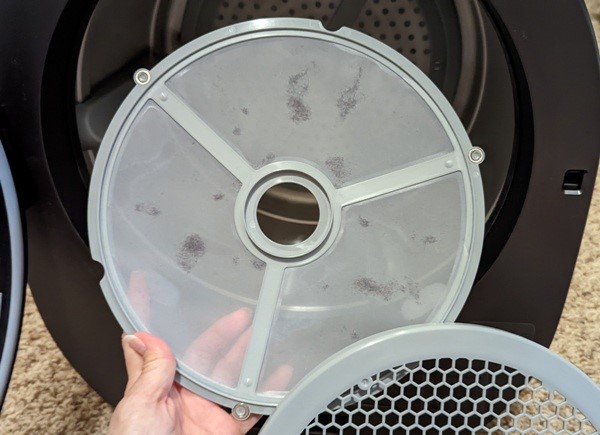
Cleaning the lint trap: The user manual suggests cleaning the lint trap after a couple of dries. Because it is held in place using magnets, it was easy enough to remove, clean, and replace.
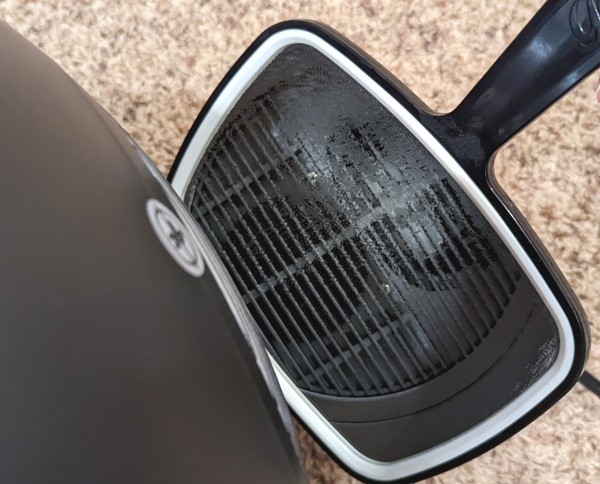
The Morus Zero vents hot humid air into the room: The Morus Zero has a condensation-collection tray, but there was never any water collected in the tray.
While drying clothes, I noticed how hot and humid my walk-in closet was getting. The dryer was venting the hot humid air directly into the room. When I placed a mirror in front of the vent, you can see the water condensing on it in the above photo.
This is an important consideration when determining where to place this dryer in your home, apartment, RV, etc. The dryer’s condenser coils were not working to remove the moisture from the air that was being vented into the room.
I found out that the Morus Zero has condenser coils that are made of plastic from watching a Morus Zero disassembly video on Youtube by Thunderf00t (at about the 20-minute mark). In order for the coils to work properly, they should have been made of metal. Plastic is a poor conductor of heat, and thus a very poor choice of material for a condensing coil.
Comparing the drying time of the Zero to my full-sized dryer
Since I don’t have any other portable dryers to compare the Morus Zero to, I had to compare it to my full-sized dryer.
Drying the same amount of my t-shirts (seven size small t-shirts) in my full-sized dryer as I did in the Morus Zero, the drying times were the same as the Morus. The benefit of using the Morus Zero with small loads is that it uses less energy because it’s smaller.
I also dried individual towels in my full-sized dryer and found that the drying times were faster than in the Zero. That was because there was more room in my big dryer so that the towels could tumble better, exposing more of the towel to the hot air circulating in the dryer.
UV sterilization and Vacuum+ technology
UV tests
Morus claims that the Zero dryer uses UV light to sterilize your clothes and vacuum technology to decrease drying time. Hmm, how was I going to test these assertions?
The first thing I did was contact Morus support to ask them what type of UV they use; specifically, what wavelength of UV they use. I was not able to get an answer to that question. So, I got Julie involved to ask for me. They responded to her:
“We are using UVC irradiation to sanitize. The peak wavelength of UVC is from 270-285nm.”
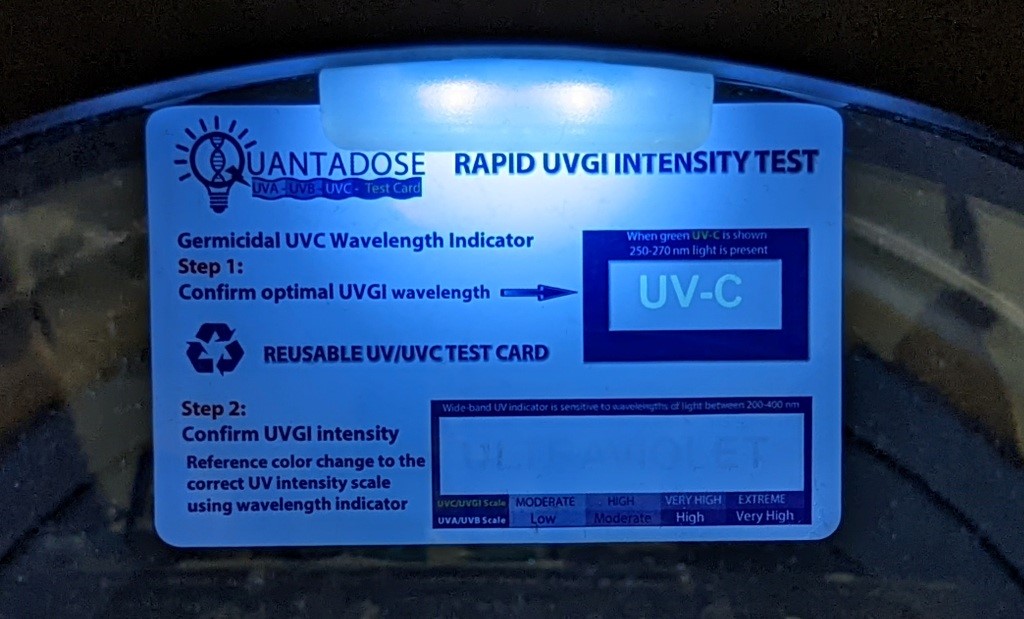
I tested each of the Morus Zero’s drying modes for the presence of UVC light using the Quantadose Rapid UVGI (ultraviolet germicidal irradiation) Intensity Test card.
When I placed the card within a centimeter of the dryer’s light and ran the dryer using each of its modes, the card detected the presence of UVC light only on the Sanitize and Refresh modes. (When UVC light is present, the “UV-C” letters glow green in “Step 1” of the card.)
You can also just barely read “ULTRAVIOLET” when it detected the UVC light. (When you can read the word “ULTRAVIOLET” in “Step 2” of the card, the UVC intensity is strong enough to sterilize.)
However, clothes don’t dry within one centimeter of the light. Also, the intensity of UVC light drops off the farther away you get from the UVC LED. So what happens when I place the card in the center of the dryer? What about the back of the dryer?
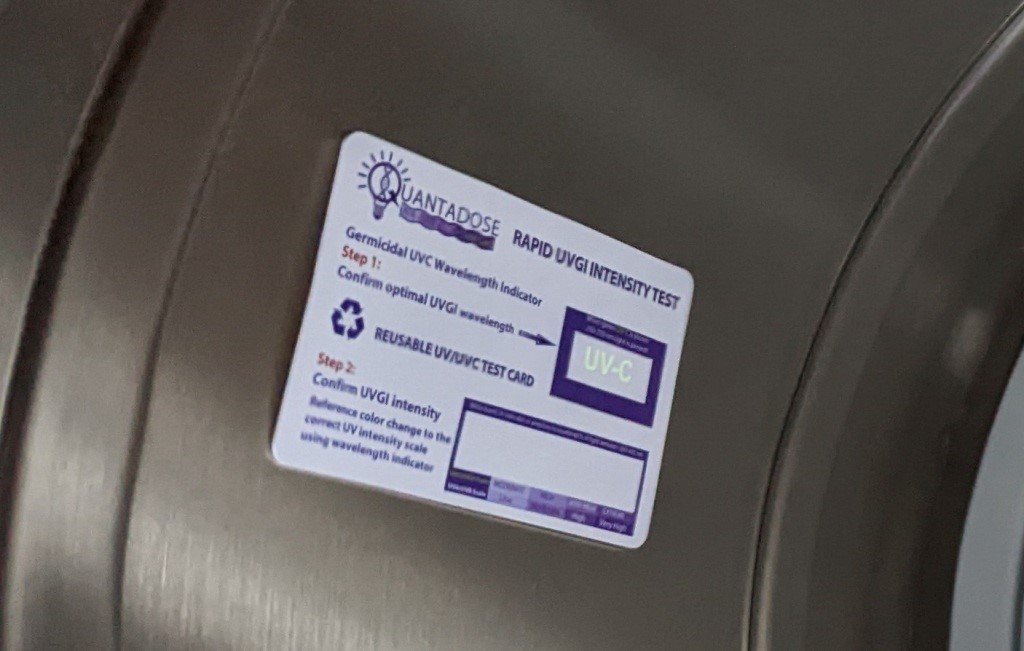
When placing the card in the center of the dryer using the Refresh mode for 6 minutes, it detects the UVC light but since you can’t read the word “ULTRAVIOLET” the intensity is not enough to sterilize your clothes.
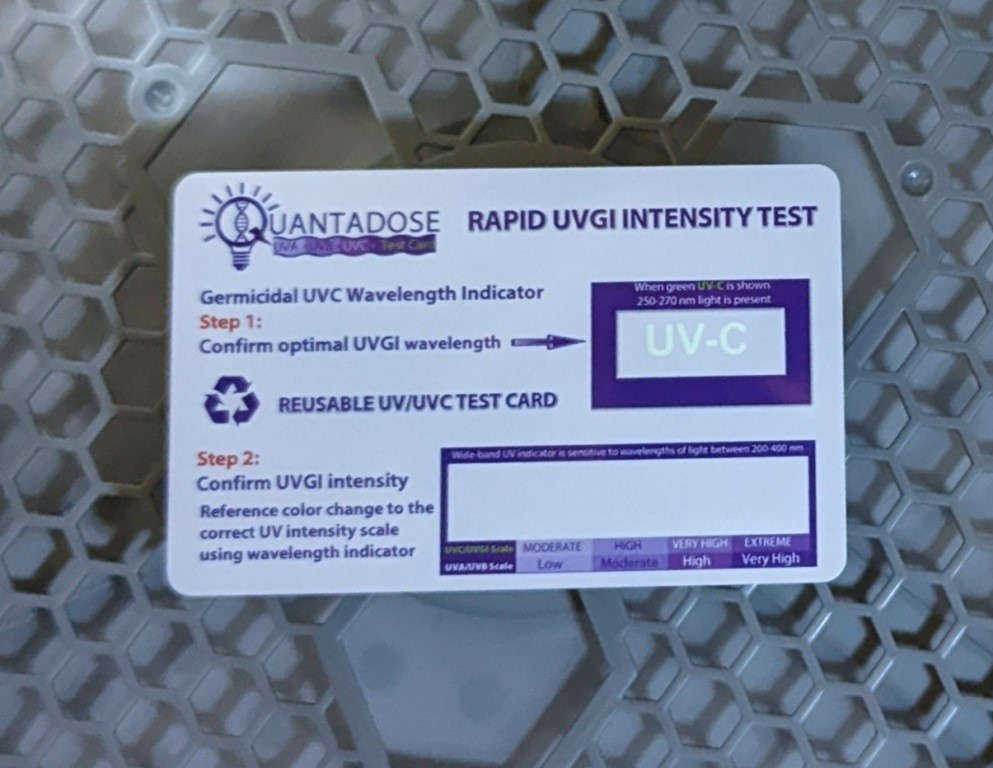
And when placing the card at the back of the dryer for a few minutes, again it detects the UVC light but the intensity is not enough to sterilize your clothes.
If you watch the Morus Zero disassembly video on Youtube by Thunderf00t, at the 27-minute mark, you can see the size and functioning of its UVC LED (I didn’t tear open my Morus Zero).
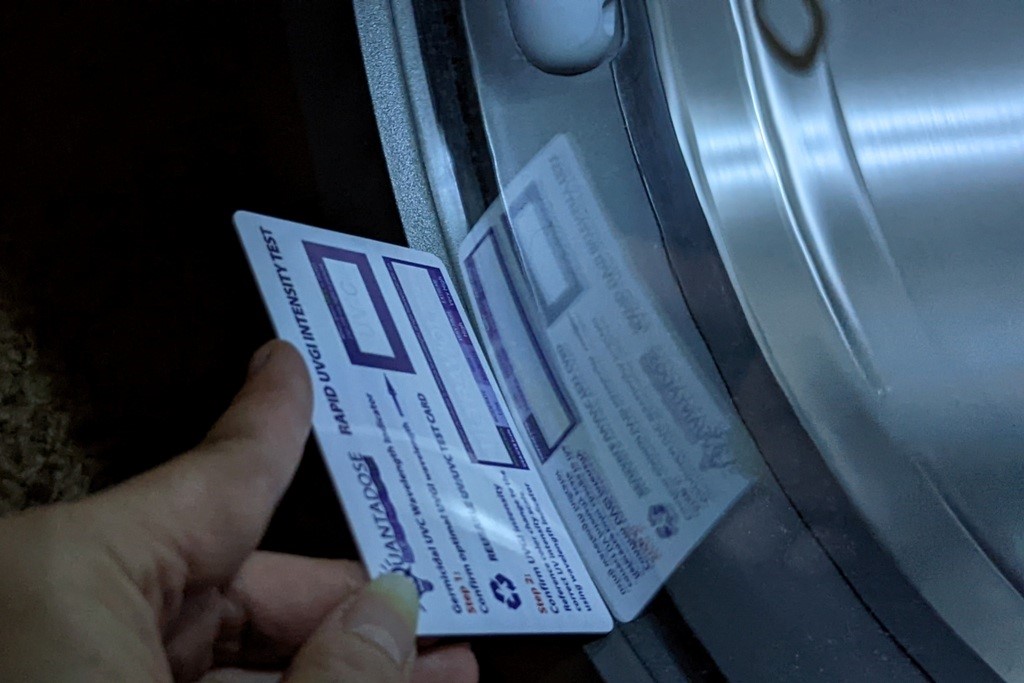
I was curious to see if the UVC light would penetrate the thin plastic window of the dryer door. This is a concern because exposure to UVC can be dangerous for your eyes and skin. As you can see, the “UV-C” letters did not glow at all so, nope, UVC light does not penetrate through the plastic window.
According to Paul A. Charp, PhD., on the Health Physics Society website when asked about UVC light penetrating acrylic (in another application, not for the Morus Zero),
The ability of UV-C light to penetrate materials will depend on the chemical composition of the materials. Most acrylic plastics will allow light of wavelength greater than 375 nm to pass through the material, but they will not allow UV-C wavelengths (100–290 nm) to pass through. Even very thin acrylic sheets of less than 5 millimeters (mm) do not let UV-C light penetrate.
Note: My interpretation of the results from using the Quantadose card is a bit simplistic since technically you need to consider several factors when determining whether your device has the ability to sterilize something. To sterilize something, a UVC light source has to deliver a certain amount of energy (intensity of UVC light) for a certain amount of time over a given surface area. And you also need to consider what kind of material you are sterilizing, how far from the UVC source the material is, etc.
Even so, using the card is a good starting point that you can use to determine if the UVC light has the potential to sterilize.
Vacuum tests
I also had Julie ask Morus support about how much of a pressure drop they create in the dryer (in inches of mercury). They responded,
“The built-in vacuum pump produces different pressure levels (0.5-1.5 inches of mercury) compared to standard atmospheric pressure, which differentiates Morus Zero from most of the traditional dryers in the market.”
According to my engineer husband,
For those of you who aren’t familiar with units of pressure measurement, vacuum pressures (those less than atmospheric pressure) are often measured by comparing to the equivalent pressure of a column of mercury (which is a very dense metallic liquid).
One atmosphere equals 14.7 pounds per square inch (psi) which equals 29.9 inches of mercury (abbreviated in Hg). What this means is that the pressure at the bottom of a 29.9 in. tall column of mercury equals 14.7 psi. A mercury vacuum gauge is a simple way to measure vacuum pressures and is a commonly used unit of atmospheric pressure (measured with a barometer).
Morus support has stated that the dryer reduces the pressure by as much as 1.5 in Hg, which is equivalent to 28.4 in Hg, or an absolute pressure of 13.9 psi. At this pressure, water boils at about 210 degrees Fahrenheit, compared to the normal 212 deg F. By comparison, the typical atmospheric pressure in a city like Denver, for instance, is about 12 psi and the boiling point of water is around 202 deg F.”
When Morus advertised the Zero dryer in a video, they stated that it uses vacuum technology that helps to speed up the drying of your clothes. They stated that it was not the kind used by vacuum cleaners but the kind of vacuum as seen in space. That implies to those watching the video that the Morus Zero is using a complete vacuum which is defined as “A space absolutely devoid of matter” according to the Merriam-Webster online dictionary.
But what they are really talking about is the engineering definition of a vacuum, which is defined as “… air pressure below atmospheric pressure” (The Engineering Toolbox website). Thus, when Youtuber Thunderf00t criticizes the Morus Zero dryer for not creating a nearly complete vacuum, Morus can contest this critique by saying that they use the engineering definition of vacuum.
To test if the Morus Zero dryer uses a vacuum (according to the engineering definition) while drying clothes, my husband found the SensorPush HTP.xw – a wireless thermometer/barometer/hygrometer to test the temperature, pressure, and humidity inside the dryer.
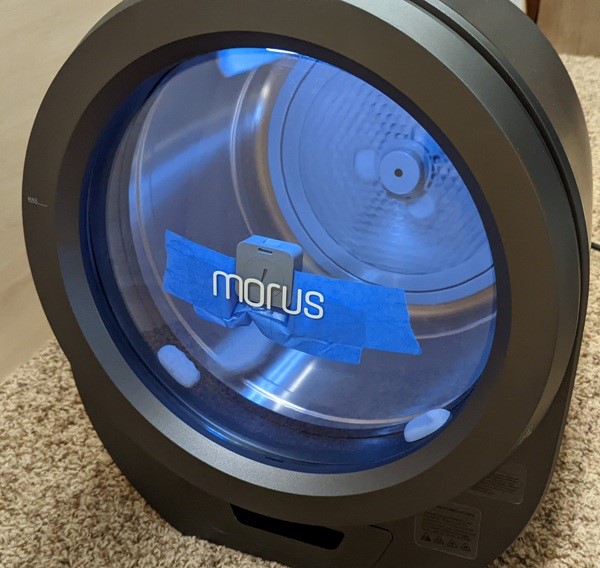
When using the SensorPush HTP.xw (taped to the inside of the door of the dryer), we found that the dryer did indeed drop the pressure, but only by 0.2 inches of mercury, which was well shy of their stated 0.5 – 1.5 inches.
According to my husband,
A reduction in pressure of 0.2 in Hg is equal to an atmospheric pressure of 14.6 psi where water boils at 211.6 deg F. This is such a negligible reduction in pressure that it isn’t really worth mentioning. And this certainly will not result in drying your clothes 60% faster …. not even close.
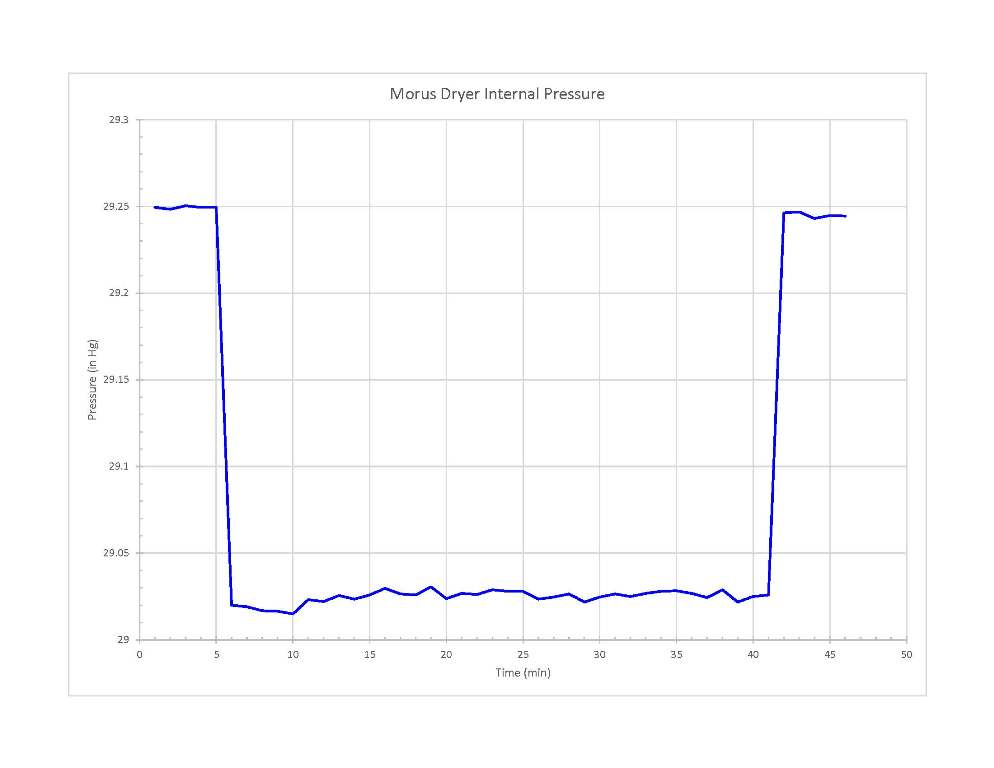
He continues,
It is evident from the plot above that the pressure drop is being generated by a fan/air pump that is moving air since it drops immediately when the dryer is turned on and immediately returns to normal when the dryer is shut off.
Our sensor was located on the door which would be representative of the pressure that the clothes are exposed to. It is possible that Morus was reporting a pressure that is very close to the suction side of the air pump, which might explain why we measured a smaller vacuum. It also seems that despite their claims that “this isn’t like the vacuum of a vacuum cleaner”, it actually is just that.
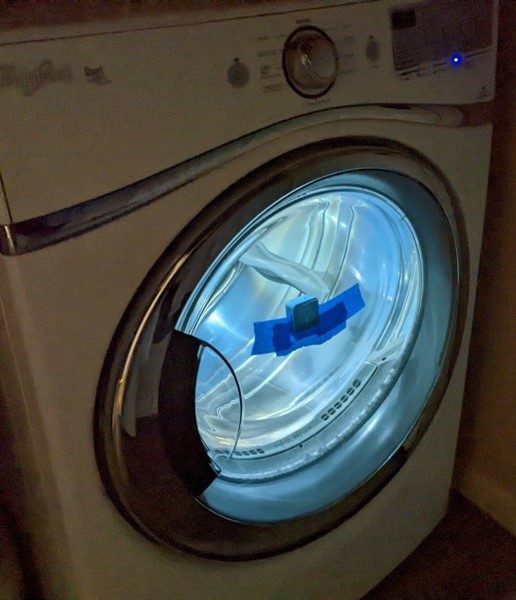
We also used the sensor to test if there was any pressure drop in our full-sized dryer and there wasn’t.
Conclusions from the UV and vacuum tests
Technically speaking, the Morus does use UVC and vacuum technology. However, neither is strong enough to sterilize clothes or speed up the drying time, respectively. It does, however, dry your clothes and use less energy than a full-size dryer would.
Is the heat of the Morus Zero enough to sterilize your clothes? I can’t really say since the information that I’ve read from a few online sources seems to indicate that a clothes dryer needs to reach a temperature of about 135-140 degrees F to significantly reduce the number of harmful microbes. I never saw the Morus Zero go above 134 degrees F. Also from what I’ve read, you have to dry clothes longer when temperatures are lower to kill microorganisms and it seems that the point of the Morus Zero is to dry small loads quickly.
What I like
- It’s small and relatively lightweight
- I like the design
- It dries seven of my t-shirts in about 23 minutes
- I didn’t have to hook up any vent hoses; I just plugged it in and used it
- It uses less energy than a full-size dryer because it is smaller
What I’d change
- While the Morus Zero does exhibit a tiny pressure drop and it does contain a small UVC LED, the drop in pressure was only 0.2 inches of mercury which is insignificant to change the drying rate and the UVC LED was not intense enough to sterilize.
- The dryer is way overpriced compared to other portable dryers
- It puts out a lot of hot humid air
Final thoughts
The Morus Zero is a nice-looking portable clothes dryer. It tries to stand out from the rest of the portable dryers by stating it uses Vacuum+ technology (a low-pressure environment) to speed up the drying time and that it uses UVC to sterilize your clothes.
Although the dryer does decrease the pressure slightly below atmospheric pressure, which is the engineering definition of a vacuum, it is such a small decrease that it doesn’t have an impact on the rate of water evaporation and thus does not dry your clothes any faster.
Additionally, while the dryer also has a UVC LED present, the intensity is not enough to sterilize your clothes. I’m not even sure that the Morus Zero’s highest temperature, which is 134 degrees F, is enough to sterilize clothes (135-140 degrees F is needed to sterilize from what I’ve read).
Furthermore, it has a plastic condensing coil and a drain tray that are useless. So instead of removing the moisture out of the air, it vents hot humid air into the room where you place it which can cause problems.
Thus, the Morus Zero is a clothes dryer that essentially uses the standard means to dry your clothes – circulating air and heat. It dries your clothes but doesn’t dry any faster than my full-size dryer.
If you’re looking for a small portable nice looking dryer that successfully dries your clothes and you don’t care about “Vacuum+ technology”, “UV Sterilization”, hot humid air venting into the room you place it in, or the $599.99 price tag, you might enjoy using the Morus Zero.
Price: $599.99
Where to buy: Morus
Source: The sample of this product was provided by Morus.

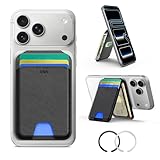

Gadgeteer Comment Policy - Please read before commenting
Excellent, informative, thorough, fabulous review. Thank you for all the time you put in.
The only thing this dryer has in common with a vacuum is that they both suck. My gosh, this company is charging $600 for so many disappointing and/or misleading aspects. Yes, you’d save a little energy, but then if you have to run the a/c to cool down the room due to the heat, there’s no benefit. And finally, the company knows their dryer doesn’t really offer a serious benefit from any vacuum technology included, yet they’re promoting this. I’d say this company doesn’t deserve us to purchase the dryer based on just this alone. The company should just leave out any vacuum nonsense and sell it as a portable vacuum and possible space heater.
I meant “portable dryer” not “portable vacuum”
O-Qua Tangin – Thank you for your kind words! I agree with you that the company should revise their marketing strategy and sell this simply as a portable dryer. I’m a bit surprised that they haven’t done so already after seeing all the reviews about it. It does dry clothes and it is portable and thus I think they should stick with that.
This company is A scam I order one it’s been over 8 months still no dryer Angela Roberts from Montreal Quebec
As the person that originally pointed out this scam of a dryer, I have to say a great big Thank You! You listened to your readers and did an extremely through review of a product that many people would be interested in. I have been coming to The-Gadgeteer daily since the beginning of the site and Julie’s (and eventually other’s) reviews and opinions have guided my purchases and recommendations ever since. This review is very reminiscent of the articles that I looked forward to for over a decade.
Nick – Thank you! I really appreciate you leaving a comment! Thanks again, for bringing the Morus Zero video reviews to my attention. Your’s and a couple of other’s comments were instrumental in encouraging me to dig into the Morus Zero. Those review videos by Thunderf00t really struck my curiosity! I’m really glad I got to review it so that I could test things out for myself and share my findings with our Gadgeteer readers. I really respect our readers and want hear what they have to say and to serve them well. You guys catch things we don’t and you challenge us too. I’m glad I was able to help put the Gadgeteer back in good standing with you!! And It was a fun investigation!
This company is A scam I order one it’s been over 8 months still no dryer Angela Roberts from Montreal Quebec
Angela – I’m so sorry about the experience you’ve had with the Morus company. I would keep trying to contact them until they respond to you:
https://morus.com/pages/contact-us
Good luck!
Great analysis!
This thing was a proven scamm for over a year now by independent testing. Why are people wasting their money on this.
Zack – Perhaps all they want is a cylindrical-shaped portable tumble dryer? It does dry clothes…
So it is a scam? I find this article too positive for something that is obviously a scam. You as a reporter should bash them for trying to sell something that is a lie. Is it sponsored by Morus?
The review is not sponsored although they did provide the sample. They had no access to the review before it was posted and they did not place any requirements on what we could say about it.
Scammer – I tried to look at the dryer from a dispassionate point of view like a scientist and ask simple questions that I could test.
– Does it use a vacuum? Yes (it drops the pressure below atmospheric pressure which is the engineering definition of vacuum).
– Is the vacuum significant enough to shorten drying time? No.
– Does the dryer use UVC? Yes.
– Is it significant enough to sterilize? No (according to the Quantadose card).
It’s designed to be a condenser tumble dryer. Does it extract the moisture from the expelled hot air? No. Hot humid air is vented from the dryer directly into the room.
The Morus Zero tries to stand out from other portable dryers and it doesn’t.
I think the rest of the review was my opinion: I liked the design, it dried my clothes, it’s way too expensive for a portable tumble dryer.
The point of a review is to try to provide information and opinions and everyone who reads the reviews makes their own decisions about the product.
Thank you for a thorough review. We are interested in a portable dryer for our fifth wheel RV and this sounded like a great solution prior to reading your review. However, venting hot humid air inside an RV is just about the last thing I’d want to do. It’s going to condense somewhere.. Your review saved us money, time and potentially a severe problem with moisture.
Dan C – I’m so glad that the review helped you! Thanks for taking the time to comment! 😁
I invested in a portable washer for my RV that was a game-changer as you will never know what people washed in laundromats. However, clothes lines are not allowed in some RV parks. I have been looking for a portable dryer. Thank you so much for the thorough review. It looks nothing magic but just a clothes dryer, wet in and dry out. I love its portable, although a bit pricey.
Robin – I’m so thankful that you found the review helpful! I do want to make sure you know that the dryer vents humid air directly into the room that it is in. Anyway, thank you for leaving a comment!
Very informative review! Thank you so much. I saw some people were using this product on RV. I didn’t even know this kind of product existed before I found it on YouTube. I live in an NYC apartment without an in-unit washer and dryer. The price of an apt with in-unit washer and dryer is too high. After reading your review thoroughly and watching other reviews on YouTube, it seems this product can dry my clothes. What I am still concerning is electricity consumption. Does it use a lot of energy?
Michael – I will have to test this and let you know in a day or two what I find out.
Michael – It appears that the Morus Zero uses between 500 – 1200 W (it oscillates as the heater kicks on and off). It hit a peak of 1400 W for a second or two. It seems to typically draw between 5 – 10 amps.
You say you reviewed this from a dispassionate, scientific perspective, but that seems like a cop-out. The context of their claims is incredibly important, and hand-waving this by saying “technically in engineering terms this dryer pulls a vacuum” and “technically there is a UV light” lends credibility to this device, which is, in no uncertain terms, A SCAM.
As an analogy, if a golfer says “I got a hole-in-one!”, you assume that they hit the ball into the hole in one go. If you later find out that they walked to the hole and dropped the ball into it, your response should not be “well, TECHNICALLY…”
It’s disingenuous. This product was made to trick people into buying an overpriced, inferior version of an off-the-shelf portable dryer by flat-out lying about not only its capabilities, but the engineering as well. There is no vacuum. It is not ventless. It’s a $600 hairdryer with a tub. It’s a scam, and the title of your review should be “I tested this scam product and it’s a scam”.